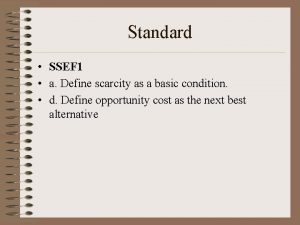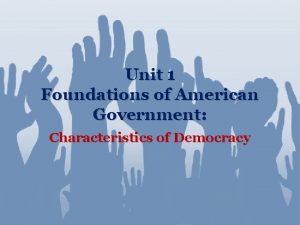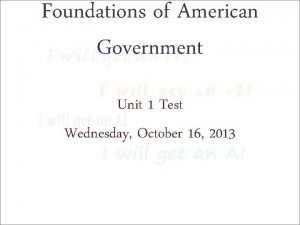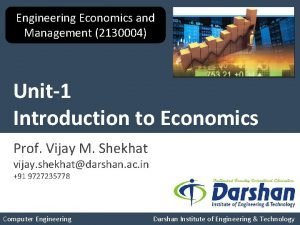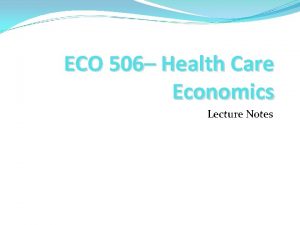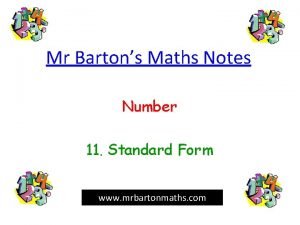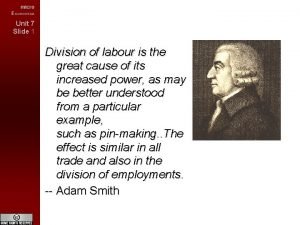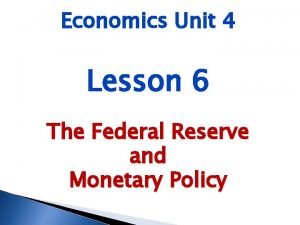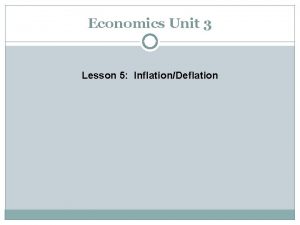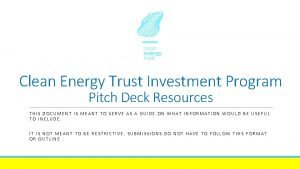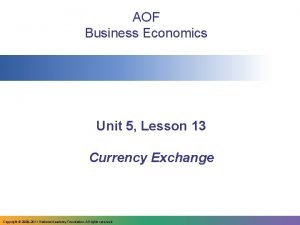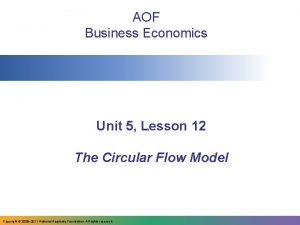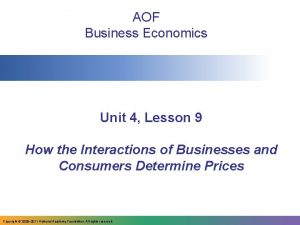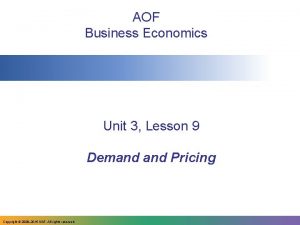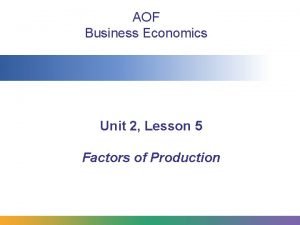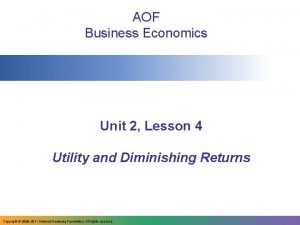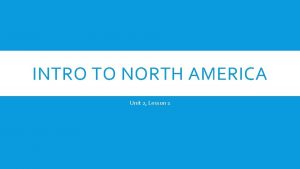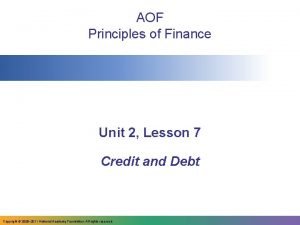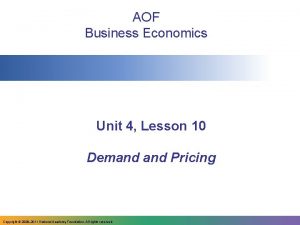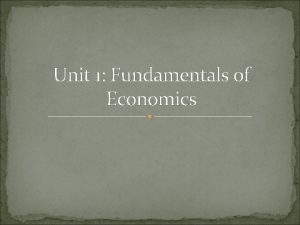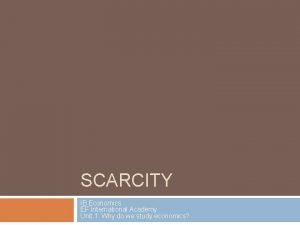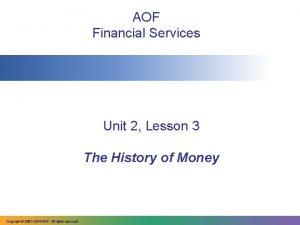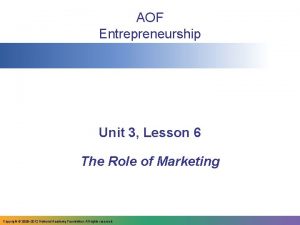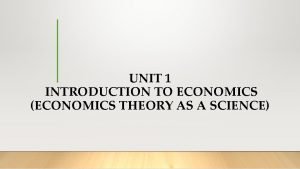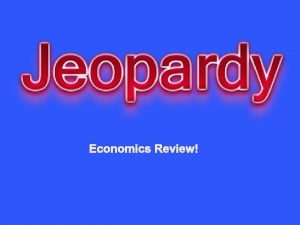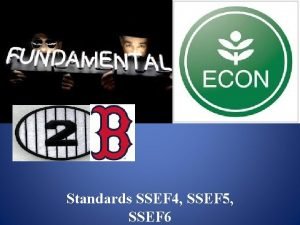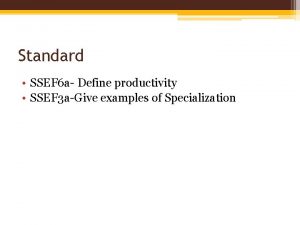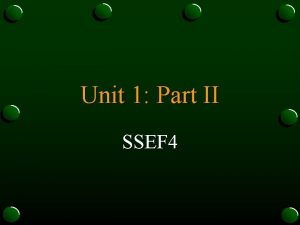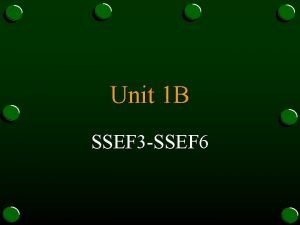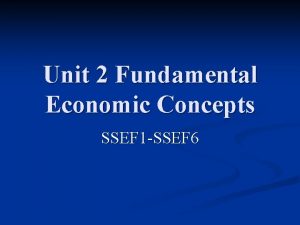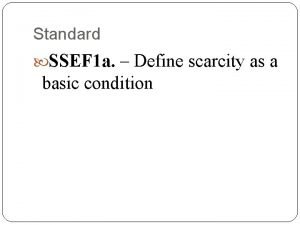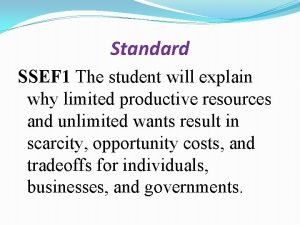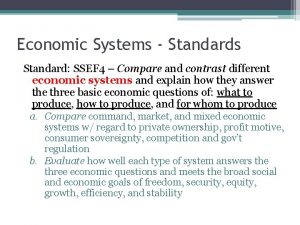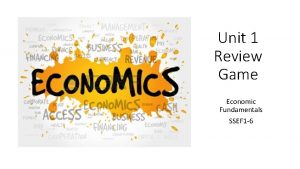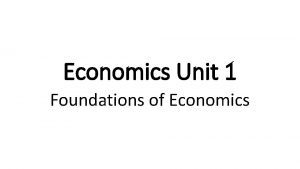Unit 1 Notes Foundations of Economics Standard SSEF

















































- Slides: 49

Unit 1 Notes Foundations of Economics

Standard SSEF 1 The student will explain why limited productive resources and unlimited wants result in scarcity, opportunity costs, and trade-offs for individuals, businesses, and governments.

EQ: Why do people have to make decisions? Economics: the study of the choices people make to satisfy their needs and wants Need: necessary for survival Want: something we desire but is not essential Examples?

Needs and wants can be further classified as… Goods: physical objects Services: actions or activities that one person performs for another

Where do g/s come from? Resources: anything that is used to make a g/s Economists call these resources “Factors of Production”

Factors of Production Land (natural resources) – Found in nature…oil, water, coal, trees Labor (human resources) – Effort that a person devotes to a task Capital (human-made resources used to make a g/s) – Physical Capital – buildings, tools, machinery – Human Capital – skills, education, etc. Entrepreneurship – risk-takers who combine resources to create g/s


EQ: Why do we have to make decisions? Scarcity! Scarcity: combination of limited resources with unlimited wants Examples?

Choices have to be made because resources are limited. Trade-offs: all of the alternatives that we give up when we choose one thing over another Examples? – Individuals – Businesses – Governments…guns and butter

Some alternatives are more desirable than others. Opportunity Cost: the value of the next best alternative “Choosing is Refusing”

Standard SSEF 2 The student will give examples of how rational decision making entails comparing the marginal benefits and the marginal costs of an action. a. Illustrate by means of a Production Possibilities Curve

EQ: What should I consider when making a choice? Opportunity Cost (of course) In addition, economists must also consider “thinking at the margin” – Deciding how much more or less to do Marginal Cost vs. Marginal Benefit

Thinking at the Margin Look at opportunity cost of each option and compare it to the benefit See Figure 1. 3 (pg. 11) a. k. a “Cost-Benefit Analysis” It is a good option when MC < MB

PPC Production Possibilities Curve: a graph that shows alternate ways to use an economy’s productive resources Comparison between two g/s “This or That”


Key Points on the Graph Efficiency: using resources to maximize production Points ALONG the PPC Underutilization: using fewer resources than an economy is capable of using Points INSIDE the PPC Future PPC – impossible to reach with given resources and technology Points OUTSIDE the PPC

Time to Practice!

Economic Goals Please read “Economic Goals and Societal Values” p. 25 -26

Economics Goals Economic Efficiency: refers to how well scarce productive resources are allocated to produce the g/s people want “Not Wasting Resources”

Economic Equity: means what is “fair”. Equity issues often arise in questions dealing with the distribution of income and wealth. Some judge equity based on providing equal opportunity. Others judge based on equality of outcomes.

Economic Freedom: refers to such things as the freedom for consumers to decide how to save or spend their incomes, change jobs, establish or close businesses “Ability to choose what you want to do…economically speaking. ”

Economic Growth: refers to increasing the production of g/s over time. This is measured by changes in the real level of Gross Domestic Product (GDP).

Economic Security: refers to protecting consumers, producers, and resource owners from risks that exist in society.

Economic Stability: refers to maintaining stable prices and full employment and keeping growth smooth and steady. (i. e. avoiding inflation/deflation)

Standard SSEF 4 The student will compare and contrast different economic systems and explain how they answer the three basic economic questions of what to produce, how to produce, and for whom to produce.

Economic System: a method used by a society to produce and distribute g/s 3 Basic Economic Questions: 1. What to Produce? 2. How to Produce? 3. For Whom to Produce? Questions are answered based on where a society prioritizes the 6 economic goals

Economic Systems 1. Traditional Economy: an economic system that relies on habit, customs, or rituals to answer the three basic questions 2. Command Economy: an economic system where a central authority (govt. ) makes all economic decisions regarding the 3 basic economic questions

More on Command Economies There are varying levels of government intervention in command economies. Socialism: philosophy that democratic means should be used to evenly distribute wealth throughout a society Communism: political and economic power rest with the govt. Authoritarian: communism with a side of crazy dictator

Kim Jong Il

Economic Systems Market Economy: system where economic decisions are made by individuals and are based on voluntary trade Market: an arrangement that allows buyers and sellers to exchange things Also known as “capitalism”

More on Market Economies Why do they exist? – Because individuals are not self-sufficient! Specialization: concentration of productive efforts of individuals and firms on a limited number of activities Examples?

Division of Labor: an arrangement in which workers perform only one step or a few steps in a larger production process (Assembly Line)

Benefits of Specialization? An increase in productivity Productivity: the quantity of output per unit of input High productivity means more g/s are being produced with the given resources (which in turn leads to a high standard of living)

Increasing Productivity Ways to INCREASE productivity include: – Division of Labor (Specialization) – Investment in PHYSICAL CAPITAL – Investment in HUMAN CAPITAL

Mixed Economy: market-based economic system that has limited government involvement Pure economic systems are hard to find in today’s world. Almost all economic systems are mixed. The continuum goes from one end where govt. intervention dominates to the opposite end where the market system dominates.

Standard SSEF 5 The student will describe the roles of government in a market economy. a. Explain why the govt. provides public g/s, redistributes income, protects private property rights, and resolves market failures b. Give examples of government regulation and deregulation and their effects on consumers and producers

Adam Smith “The Invisible Hand” Famous British economist Wrote The Wealth of Nations Argued that governments should NOT intervene in a market economy. Stated governments should follow an economic policy of “laissez-faire” (let them do)

Adam Smith Continued Argued that an “invisible hand” would guide a market economy without needing help from the govt. Self-interest usually guides individuals to meet the needs of consumers

The Role of Government in a Market Economy Provide Public G/S – Public Good: a g/s that is characterized by shared consumption and non-exclusion Ex. Roads, dams, parks, etc. – G/S that the govt. has to provide or else it wouldn’t be done Redistribute Income – Govt. provides a “safety net” to ease poverty – Poverty Threshold 2009 (family of 4): $21, 954 – Done via welfare programs

The Role of Government in a Market Economy Protect Private Property Rights – Issues of Eminent Domain – Includes “intellectual property” Copyrights: permission to use works of another (music, art, literary, etc. ) Patents: exclusive right to your invention for a certain number of years

The Role of Government in a Market Economy Resolves Market Failures – Market Failure: a situation where the market does not (on its own) distribute resources efficiently – Govt. steps in to “fix” the problem – Examples: traffic congestion, pollution

Role of Govt. Continued Regulation: rules or laws set by govt. which could limit productivity but protect consumers Deregulation: removal of govt. rules that constrain market forces

Standard SSEF 6 The student will explain how productivity, economic growth, and future standards of living are influenced by investment in factories, machinery, new technology, and the health, education, and training of people.

Investment for the Future Refer back to PPC How can we get to the point to the right of the curve? Become more productive by improving what you have! New buildings, machinery, new technologies Health, education, and training of workforce

Investment for the Future How can investing in your education lead to a higher standard of living?



Model of Circular Flow $$$ Payment for G/S Product Market G/S La nd Households $$$ Income $$$ Payment for G/S , L a C & ab or l a pit Firms $$$ Wages Factor Market

Circular Flow in a Market Economy See the model in action
 Unit 1 review fundamental economic concepts answers
Unit 1 review fundamental economic concepts answers Florida state science fair
Florida state science fair Broward county science fair
Broward county science fair Ssef price list
Ssef price list Conversion notes brutes en notes standard wisc 5
Conversion notes brutes en notes standard wisc 5 Unit 1 foundations of american government
Unit 1 foundations of american government Foundations of american government unit 1 test review
Foundations of american government unit 1 test review Economics and business economics maastricht
Economics and business economics maastricht Econ213
Econ213 Land use planning lecture notes
Land use planning lecture notes 2130004
2130004 Health economics lecture notes
Health economics lecture notes Unit 10, unit 10 review tests, unit 10 general test
Unit 10, unit 10 review tests, unit 10 general test Standard form maths
Standard form maths Standard error in the mean
Standard error in the mean Standard language in sociolinguistics
Standard language in sociolinguistics Standard cost definition
Standard cost definition Mbk berkefungsian sederhana
Mbk berkefungsian sederhana Unit economics slide
Unit economics slide Unit 4 lesson 6
Unit 4 lesson 6 Economics unit 3 lesson 1 demand
Economics unit 3 lesson 1 demand Unit economics slide
Unit economics slide Economics unit 5 lesson 4
Economics unit 5 lesson 4 Economics unit 5 lesson 5
Economics unit 5 lesson 5 Economics unit 4 lesson 5
Economics unit 4 lesson 5 Economics unit 3 lesson 9
Economics unit 3 lesson 9 Economics unit 2 lesson 5
Economics unit 2 lesson 5 Economics unit 2 lesson 2
Economics unit 2 lesson 2 Economics unit 4 lesson 4
Economics unit 4 lesson 4 Economics unit 4 lesson 9
Economics unit 4 lesson 9 World geography unit 9 lesson 1
World geography unit 9 lesson 1 Lesson 2 our economic choices
Lesson 2 our economic choices Personal finance unit 2 lesson 2
Personal finance unit 2 lesson 2 Economics unit 2 lesson 4
Economics unit 2 lesson 4 Economics unit 4 lesson 7
Economics unit 4 lesson 7 Economics unit 5 lesson 10
Economics unit 5 lesson 10 Unit 1 economics
Unit 1 economics Economics unit 1 answer key
Economics unit 1 answer key Ib economics unit 1
Ib economics unit 1 Economics unit 3 lesson 7
Economics unit 3 lesson 7 Unit 2 lesson 3 health insurance and financial planning
Unit 2 lesson 3 health insurance and financial planning Economics unit 2 lesson 3
Economics unit 2 lesson 3 Entrepreneurship unit 3
Entrepreneurship unit 3 Economics unit 3 lesson 7
Economics unit 3 lesson 7 Unit 3 lesson 15 marketing
Unit 3 lesson 15 marketing Unit 1 introduction to economics
Unit 1 introduction to economics Unit 1 review economics
Unit 1 review economics Criminology unit 4 notes
Criminology unit 4 notes Spm unit 4 notes
Spm unit 4 notes Ap chemistry unit 9 notes
Ap chemistry unit 9 notes



